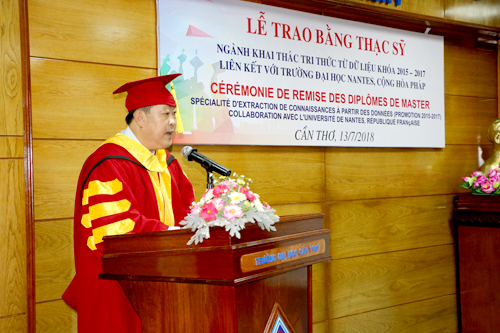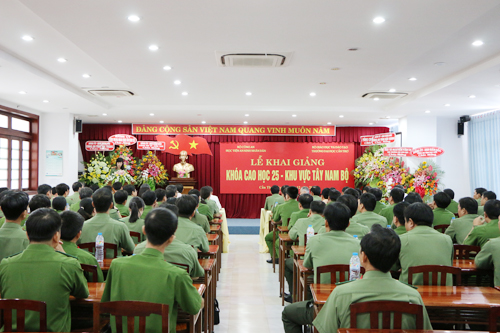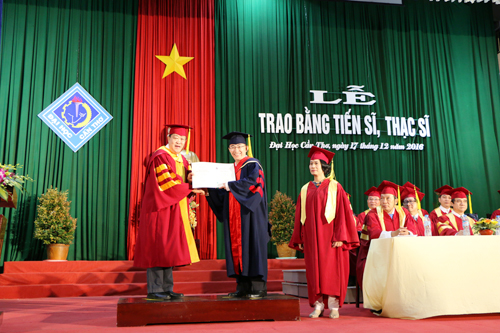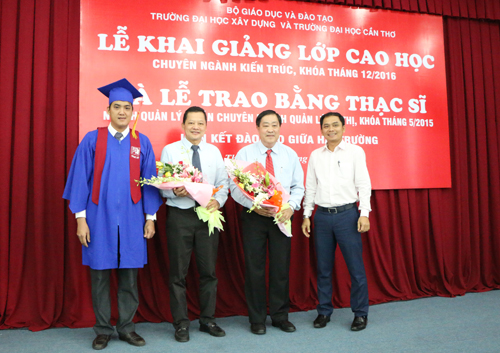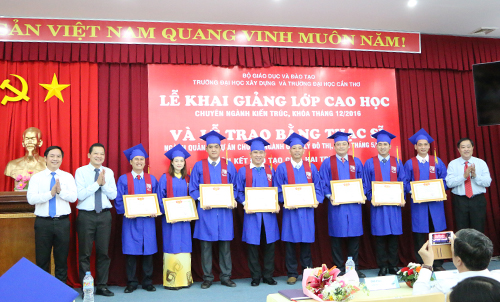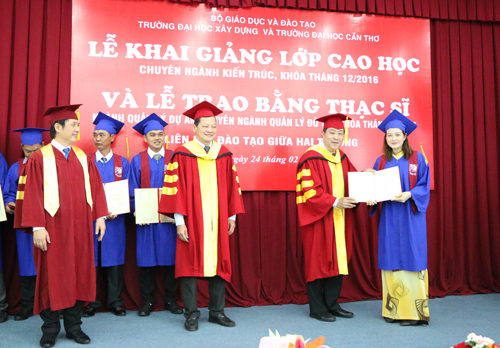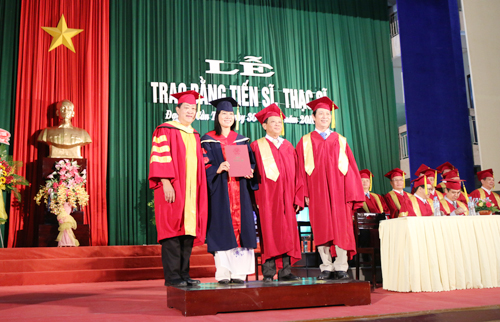
Tên đề tài: “Nghiên cứu Đặc điểm sinh học sinh sản và kích thích sinh sản nhân tạo cá sát sọc Pangasius macronema”.
Tác giả: Trần Đông Phương An, Khóa: 2017
Ngành: Nuôi trồng thủy sản; Mã số: 9620110. Nhóm ngành: Nông-Lâm-Ngư nghiệp
Người hướng dẫn chính: PGS.TS. Bùi Minh Tâm - Trường Đại học Cần Thơ
Người hướng dẫn phụ: PGS.TS. Phạm Thanh Liêm - Trường Đại học Cần Thơ
- Tóm tắt nội dung luận án
Nghiên cứu được thực hiện từ 2020-2023 tại Trường Thủy sản- Trường Đại học Cần Thơ. Mục tiêu của nghiên cứu nhằm xác định đặc điểm sinh học sinh sản, biện pháp nuôi vỗ, kích thích sinh sản nhân tạo và ương cá sát sọc, góp phần phát triển nghề sản xuất giống và nuôi cá sát sọc ở Việt Nam. Nội dung nghiên cứu gồm: Nội dung nghiên cứu gồm: (1) Đặc điểm sinh học sinh sản của cá sát sọc, (2) Nuôi vỗ cá bố mẹ với các hàm lượng đạm khác nhau (30%, 35% và 40%), phân tích huyết học và vitellogenine, (3) Sinh sản nhân tạo cá với các loại kích thích tố khác nhau, (4) Sự phát triển ống tiêu hóa của cá bột, (5) Sự chọn lọc thức ăn tự nhiên của cá bột, (6) Xác định thời điểm chuyển đổi thức ăn chế biến, (7) Ương cá bột với mật độ khác nhau.
Mẫu nghiên cứu đặc điểm sinh học sinh sản của cá sát sọc được thu trong 13 tháng, mỗi tháng thu khoảng 90 con (n=1170 con) tại 3 điểm dọc theo tuyến sông Hậu. Mẫu cá sau khi thu sẽ được vận chuyển về phòng thí nghiệm để phân tích các chỉ tiêu sinh học sinh sản của cá. Kết quả cho thấy, cá sát sọc có tuyến sinh dục ở giai đoạn III và IV chiếm tỷ lệ cao chủ yếu từ tháng 3 đến tháng 8, với hệ số thành thục dao động 5,08 – 7,16%. Độ béo Clark dao động 0,60 – 1,12%. Sức sinh sản tuyệt đối trung bình là 6.007±4.484 trứng/cá thể và sức sinh sản tương đối trung bình là 161±71 trứng/g cá cái. Kết quả trên cho thấy mùa vụ sinh sản của cá từ tháng 3 đến tháng 8.
Sau 9 tháng nuôi vỗ bằng thức ăn công nghiệp có lượng 30%, 35% và 40% đạm, cá thành thục cao hơn so với 2 nghiệm thức còn lại khi cho ăn thức ăn 40% đạm với tỷ lệ thành thục lên đến 60%, hệ số thành thục đạt 2,68±0,19% và sức sinh sản tương đối thực tế trung bình là 48.640±22.355 trứng/kg cá cái. Hàm lượng vitellogenine 9,6 ± 1,7 (µgALP/mg protein) cao nhất ở nghiệm thức 40% đạm
Cá không rụng trứng khi tiêm cho cá cái 150µg LH-RHa+20mg DOM/kg, 5mg não thùy/kg, 2500UI HCG+ 2,5mg não/kg, 0,4-0,6ml Ovaprim/kg cá cái. Cá đã rụng trứng khi tiêm HCG với liều 5.000, 5.500, 6.000, 6.500UI/kg cá cái. Cá sinh sản tốt nhất khi tiêm liều 6.000UI/kg.
Hệ tiêu hóa của cá hoàn chỉnh vào ngày thứ 9 sau khi nở với sự xuất hiện của tuyến dạ dày. Thời điểm này ngoài việc cá bắt thức ăn tươi sống có kích cỡ lớn thì cá cũng có thể ăn thức ăn chế biến.
Thức ăn của cá sát sọc bột chủ yếu là phiêu sinh động vật, nhưng thành phần và kích cỡ thức ăn của cá Sát sọc bột thay đổi theo sự phát triển của ống tiêu hóa. Giáp xác râu ngành (moina) là thức ăn ưa thích của cá sát sọc kể từ khi bắt đầu sử dụng thức ăn ngoài với tần số xuất hiện là 100%. Ngoài ra luân trùng được cá chọn lựa từ giai đoạn 3 ngày tuổi đến 6 ngày tuổi
Các nghiên cứu sử dụng thức ăn chế biến ương cá sát sọc đã ghi nhận, tỷ lệ sống của cá phụ thuộc vào mật độ, ngày tuổi tập cho cá ăn thức ăn thức ăn chế biến. Khi ương với mật độ 2 con/L và tập cho cá ăn thức ăn chế biến từ ngày tuổi 12 với phương thức thay thế dần thức ăn chế biến đã cho tỷ lệ sống của cá đạt (27,78%).
- Những kết quả mới của luận án
Các kết quả nghiên cứu đặc điểm sinh học sinh sản, kỹ thuật sinh sản nhân tạo cá sát sọc lần đầu tiên được công bố ở Việt Nam. Nội dung của luận án gồm những điểm mới sau đây:
- Xác định được một số đặc điểm sinh học sinh sản gồm: Sự phát triển của tuyến trứng, tuyến tinh; Xác định các chỉ tiêu: Hệ số thành thục và Sức sinh sản, Chỉ số điều kiện, Tương quan giữa chiều dài và khối lượng; Chiều dài thành thục. Mùa vụ sinh sản của cá sát sọc ngoài tự nhiên.
- Xác định được hàm lượng đạm thích hợp (40% protein) trong nuôi vỗ, kích thích tố HCG với liều 6.000 UI để kích thích sinh sản nhân tạo.
Kết quả ương cá bột lên cá hương:
- Sự phát triển ống tiêu hóa của cá bột hoàn chỉnh vào 9 ngày tuổi.
- Thời điểm chuyển đổi thức ăn chế biến vào 12 ngày tuổi sau khi nở.
- Mật độ thích hợp để ương cá bột lên cá hương là 2 con/lít.
- Có sự tăng trưởng về khối lượng và chiều dài khi cho cá bột ăn động vật phiêu sinh kết hợp với thức ăn đậm đặc (dạng bột) so với cho ăn toàn động vật phiêu sinh
- Các ứng dụng/khả năng ứng dụng trong thực tiễn, các vấn đề cần tiếp tục nghiên cứu
Các kết quả đạt được về kỹ thuật sản xuất giống sẽ ứng dụng vào thực tế ở quy mô nông hộ, gồm: Kỹ thuật nuôi vỗ cá bố mẹ, biện pháp kích thích cá sinh sản và kỹ thuật ương nuôi cá từ giai đoạn cá bột lên cá giống.
Các vấn đề cần tiếp tục nghiên cứu:
- Nghiên cứu tăng liều lượng Ovaprim để kích thích sinh sản cá sát sọc.
- Nghiên cứu một số chất bổ sung (vitamin E, Zn, khoáng, …) vào thức ăn nhằm tăng mức độ thành thục sinh dục của cá sát sọc trong quá trình nuôi vỗ.
- Nghiên cứu kết hợp các loại hormon khác nhau nhằm tăng hiệu quả kích thích sự rụng trứng cá sát sọc.
- Nghiên cứu các đặc điểm dinh dưỡng (tính ăn, nhu cầu đạm, lipid,…), sinh lý cá bột, cá giống nhằm có giải pháp chăm sóc hợp lý giúp tăng tỷ lệ sống cá sát sọc trong ương nuôi.
Thesis title: The study on reproductive biology and inducing artificial propagation of long-barbel catfish (Pangasius macronema)
- Major: Aquaculture Code: 62620301
- Full name of PhD student: Tran Dong Phuong An Year: 2017
- Scientific supervisor:
Assoc. Prof. Dr. Bui Minh Tam
Assoc. Prof. Dr. Pham Thanh Liem
- Educational institution: Can Tho Univercity
- Content of thesis summary
This research was conducted from 2020 to 2023 at College of Aquaculture and Fisheries (CAF) - Can Tho University. The study aimed to determine the reproductive biology, conditioning and artificial spawning induction techniques, and larval rearing of the long-barbel catfish (Pangasius macronema), contributing to the development of the long-barbel catfish seed production and farming industry in Vietnam. The research contents included: (1) Reproductive biology of Long barbel catfish, (2) Conditioning of broodfish with different protein levels (30%, 35% and 40%), hematological analysis and vitellogenine, (3) Artificial spawning of fish with different types of hormones, (4) Digestive tract development of larvae, (5) Selection of natural food for larvae, (6) Determination of the time for switching to home-made feed, (7) Larval rearing at different densities.
The sample for reproductive biology studies of long-barbel catfish was collected over 13 months, with approximately 90 fish (n=1170) collected per month from 3 locations along the Hau River. After collection, the fish were transported to the CAF’s Laboratory, Can Tho University, for analysis of the reproductive biological indicators. The results showed that long barbel catfish with gonad stages III and IV accounted for a high proportion, primarily from March to August, gonadosomatic index (GSI) ranged from 5.08 to 7.16%. Clark fat ranged from 0.60 to 1.12%. The average absolute fecundity was 6,007±4,484 eggs/individual and the average relative fecundity was 161±71 eggs/g female fish. These results indicate that the spawning season of the fish is from March to August.
After 9 months of conditioning with home made feed containing 30%, 35%, and 40% protein, the fish showed higher maturity when fed with 40% protein feed compared to the other two treatments, reaching a maturity rate of 60%, GSI 2.68±0.19%, and actual relative fecundity of 48,640±22,355 eggs/kg female fish. The vitellogenine level was highest at 9.6 ± 1.7 (µgALP/mg protein) in the 40% protein treatment.
The fish did not ovulate when injected with 150µg LH-RHa+20mg DOM/kg, 5mg pituitary gland/kg, 2500UI HCG+ 2.5mg pituitary gland/kg, or 0.4-0.6ml Ovaprim/kg female fish. The fish ovulated after being injected with HCG at doses of 5000, 5500, 6000, and 6500UI/kg female fish. The best spawning was observed with a dose of 6000UI/kg.
The digestive system of the larvae was complete on the 9th day after hatching with the appearance of the gastric gland. At this time, in addition to consuming live food with a larger size, the larvae could also consume home made feed.
The primary food of long barbel catfish larvae was zooplankton, but the composition and size of the larvae’s food change as the digestive tract developed. Cladocera (moina) was the preferred food for long-barbel catfish from the time they begin external feeding, with an occurrence frequency of 100%. Additionally, rotifers were selected by the fish from the 3rd day to the 6th day of age.
Studies using home made feed for rearing long barbel catfish larvae have recorded that the survival rate of the fish depended on the density and age at which larvae fish fed to home made feed. Rearing at a density of 2 individual/L and training for artificial feed from the 12th day of age with a gradual replacement method resulted in a survival rate of 27.78%, better than the other treatments.
- The novel aspects from the thesis
*Identification of some reproductive biological characteristics including: Development of ovary and testis; determination of indicators: Gonadosomatic index and Fecundity; Condition factor; Length-weight relationship; Length at maturation. Determination of the spawning season of long-barbel catfish in the wild.
*Identification of suitable protein level (40% protein) in the feed for broodfish coditioning, and the hormone HCG at a dosage of 6,000 IU for artificial reproduction.
*Results for rearing larvae to fingerling stage:
-The digestive tract of the larval fish completes its development by 9 days old.
-The optimal time to transition to home-made feeds is 12 days after hatching.
-The suitable density for rearing larval fish to fingerling is 2 individuals per liter.
-There is an increase in weight and length when fry are fed a combination of zooplankton and concentrated feed (powder form) compared to being fed only zooplankton.
- Application prospect and suggestions for further study
The results on juvenile production techniques will be applied in practice at the household level, including: broodfish conditioning techniques, stimulating artificial propagation, and rearing from larvae to fingerling size.
- suggestions for further study
*Study on increasing Ovaprim dosage to induce artificial propagation of long-barbel catfish.
*Investigate the use of supplements (vitamin E, Zn, minerals, etc.) in the diet to increase the sexual maturation of fish during rearing.
*Research combining different hormones to improve the efficiency of inducing ovulation in fish.
*Study the nutritional characteristics (feeding habits, protein requirements, lipid requirements, etc.) and physiology of larvae and juveniles to develop suitable care solutions to increase the survival rate of long-barbel catfish in rearing.
- Xem chi tiết nội dung luận án
- Xem thông tin đăng tải tại Website Bộ giáo dục và Đào tạo. (Nhập tên NCS vào ô tìm kiếm)





